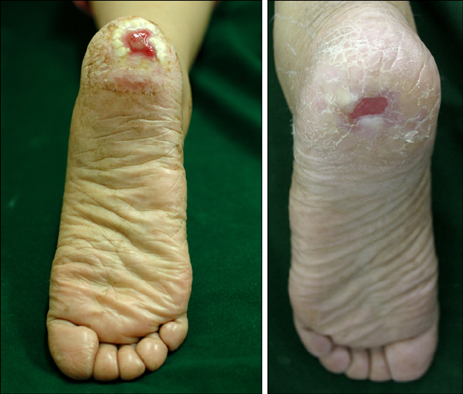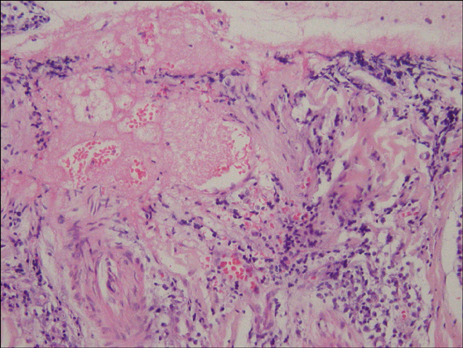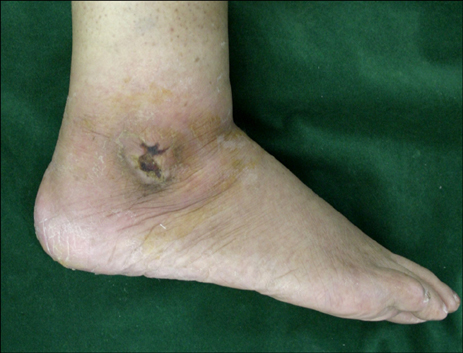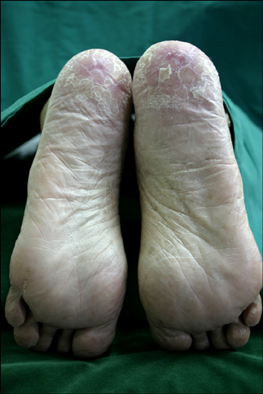Ann Dermatol.
2009 Feb;21(1):39-41. 10.5021/ad.2009.21.1.39.
A Hydroxyurea-induced Leg Ulcer
- Affiliations
-
- 1Department of Dermatology, Busan Paik Hospital, College of Medicine, Inje University, Busan, Korea. btyouth@hanmail.net
- KMID: 2172063
- DOI: http://doi.org/10.5021/ad.2009.21.1.39
Abstract
- Hydroxyurea is a cytostatic agent that has recently become the drug of choice in the treatment of various myeloproliferative diseases. The cutaneous side effects of hydroxyurea include xerosis, hyperpigmentation, nail discoloration, and scaling. Leg ulcers have only rarely been reported in association with hydroxyurea treatment. A 75-year-old woman presented with leg ulcers, nail discoloration, and xerosis. The leg ulcers were refractory to conventional treatment. She had been taking oral hydroxyurea since being diagnosed with essential thrombocytosis in 2002. Hence, we suspected hydroxyurea-induced leg ulcers and discontinued her hydroxyurea treatment; the ulcers gradually healed thereafter. We present a rare case of hydroxyurea-induced leg ulcers in Korea.
Keyword
MeSH Terms
Figure
Reference
-
1. Sirieix ME, Debure C, Baudot N, Dubertret L, Roux ME, Morel P, et al. Leg ulcers and hydroxyurea: forty-one cases. Arch Dermatol. 1999. 135:818–820.2. Park JH, Kim CD, Ryoo YW, Kim BC, Lee KS. Chronic hydroxyurea-induced dermatomyositis-like eruption showing epidermal dysmaturation. Ann Dermatol. 2002. 14:28–30.
Article3. Weinlich G, Schuler G, Greil R, Kofler H, Fritsch P. Leg ulcers associated with long-term hydroxyurea therapy. J Am Acad Dermatol. 1998. 39:372–374.
Article4. Najean Y, Rain JD. Treatment of polycythemia vera: the use of hydroxyurea and pipobroman in 292 patients under the age of 65 years. Blood. 1997. 90:3370–3377.
Article5. Yarbro JW. Mechanism of action of hydroxyurea. Semin Oncol. 1992. 19:1–10.6. Demircay Z, Comert A, Adiguzel C. Leg ulcers and hydroxyurea: report of three cases with essential thrombocythemia. Int J Dermatol. 2002. 41:872–874.
Article7. Best PJ, Daoud MS, Pittelkow MR, Petitt RM. Hydroxyurea-induced leg ulceration in 14 patients. Ann Intern Med. 1998. 128:29–32.
Article8. Nguyen TV, Margolis DJ. Hydroxyurea and lower leg ulcers. Cutis. 1993. 52:217–219.9. Engstrom KG, Lofvenberg E. Treatment of myeloproliferative disorders with hydroxyurea: effects on red blood cell geometry and deformability. Blood. 1998. 91:3986–3991.
Article10. Rodgers GP, Dover GJ, Uyesaka N, Noguchi CT, Schechter AN, Nienhuis AW. Augmentation by erythropoietin of the fetal-hemoglobin response to hydroxyurea in sickle cell disease. N Engl J Med. 1993. 328:73–80.
Article11. Bader U, Banyai M, Boni R, Burg G, Hafner J. Leg ulcers in patients with myeloproliferative disorders: disease- or treatment-related? Dermatology. 2000. 200:45–48.
Article12. Dissemond J, Hoeft D, Knab J, Franckson T, Kroger K, Goos M. Leg ulcer in a patient associated with hydroxyurea therapy. Int J Dermatol. 2006. 45:158–160.
Article13. Stagno F, Guglielmo P, Consoli U, Fiumara P, Russo M, Giustolisi R. Successful healing of hydroxyurea-related leg ulcers with topical granulocyte-macrophage colony-stimulating factor. Blood. 1999. 94:1479–1480.
Article14. Yun SJ, Lee JB, Kim SJ, Lee SC, Won YH. A case of hydroxyurea-induced cutaneous ulceration and squamous cell carcinoma. Korean J Dermatol. 2002. 40:433–436.15. Jang SJ, Moon YJ, Choi YH, Kim JH, Won JY. A case of cutaneous manifestations associated with hydroxyurea therapy. Korean J Dermatol. 2003. 41:965–967.





